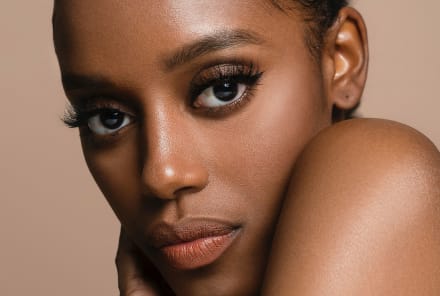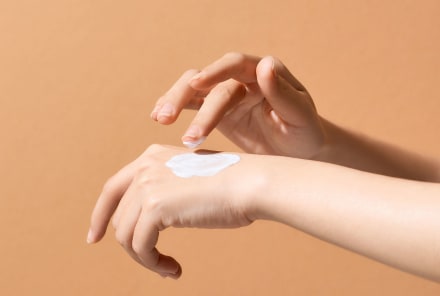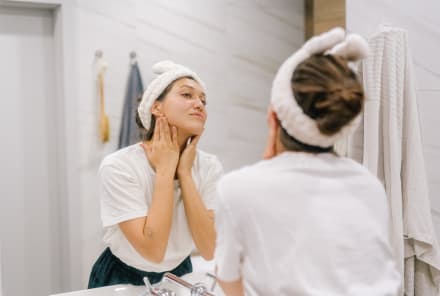Advertisement
Phenoxyethanol: What Is It & Is It Safe In Skin Care? Our Research To Help You Decode


As certain skin care ingredients fall out of favor with consumers, brands have been switching up their formulas to accommodate the demand. And often, this involves ditching the parabens and using a chemical called phenoxyethanol instead. But what is phenoxyethanol, exactly? And is it even safe? Here, we dive in.
What is phenoxyethanol?
According to board-certified dermatologist Kiran Mian, D.O., phenoxyethanol is a preservative that's used in cosmetics, perfumes, and toiletries. It's colorless, oily, and has a rose-like odor. Chemically speaking, it's an ether alcohol that's naturally found in green tea. But most of the phenoxyethanol you'll come across is synthesized in a lab.
On that note, you probably use this chemical more often than you think. About 23.9% of personal products contain phenoxyethanol1, so it's a pretty common preservative. It's likely in most of your products, from leave-on cosmetics (like lipsticks) to rinse-off formulas (like cleansers).
And you're probably about to see a lot more of it, too. With the increasing popularity of paraben-free products, many skin care brands have used phenoxyethanol in place of parabens. It can be listed on a label under several names, including 2-phenoxyethanol, phenoxytol, ethylene glycol monophenyl ether, and 1-hydroxy-2-phenoxyethane.
What is phenoxyethanol?
What is phenoxyethanol used for in skin care?
In skin care, phenoxyethanol is used to enhance the quality, safety, and effectiveness of a product. Here's how it works:
It prevents microbial growth
Although it may sound unpleasant, your cosmetic products double as the perfect home (and food) for harmful microorganisms. It's all thanks to water and organic/inorganic compounds2, which is found in basically every product.
Phenoxyethanol helps by preventing the growth of bacteria3, yeast, and mold, says Jessie Cheung, M.D., board-certified dermatologist. It fights bacteria by making holes in their membranes, which essentially makes them implode, adds Mian. Phenoxyethanol also disrupts DNA and RNA synthesis in bacteria and yeast, so it's impossible for them to reproduce, she notes. In turn, these microbes can't multiply and contaminate your beloved skin care products.
It stabilizes products
"Phenoxyethanol is compatible with many other preservatives," says Cheung, and it doesn't react with light or air. Therefore, it's used to prevent ingredients from breaking down or separating, helping your product stay stable. What's more, phenoxyethanol itself is stable at a wide range of pHs, notes Cheung, so it works well in a variety of formulas.
It enhances the shelf life of your products
As a preservative, phenoxyethanol is ultimately used to extend a product's lifespan. Its antimicrobial and stabilizing properties protect the formula from spoilage, which would render the product useless—and unsafe. This increases the length of time you can enjoy the product without any issues. (It's still smart to check the expiration date, though!)
Are there any side effects?
Phenoxyethanol is generally recognized as a safe, well-tolerated preservative3. Yet, there have been a few reports of this substance causing adverse effects.
In a 2010 case study, a woman developed an allergic reaction—in the form of hives and anaphylaxis—after using a skin care product with phenoxyethanol. The researchers did a specific phenoxyethanol skin test and found that she was allergic to the preservative. There was also a 2015 report of phenoxyethanol causing irritation. The preservative, which was applied via ultrasound gel, led to contact dermatitis.
Also, in 2008, the FDA issued a warning "for a nipple cream containing phenoxyethanol and chlorphenesin, another preservative [that causes] central nervous system effects, as the two ingredients could synergistically increase the risk of respiratory depression in nursing infants," says Cheung.
Finally, in animal studies, phenoxyethanol has caused negative effects at very high doses. However, any potential toxicity happens at exposure levels much higher—around 200 times more3—than what's used in cosmetics.
It's also worth noting that reports of side effects are rare—extremely rare. (Consider them the exception, not the rule.) When used at the low concentrations (less than 1%) found in cosmetics, phenoxyethanol is unlikely to cause harmful or unpleasant outcomes.
Summary
Who shouldn't use it?
"Even though phenoxyethanol is regarded as low-risk, you can be sensitized to any chemical," explains Cheung. So, if you have sensitive skin, she recommends proceeding with caution when using any new skin care products—including those with phenoxyethanol.
If you think you have a phenoxyethanol allergy, do a patch test first, suggests Mian. Apply a small amount to your inner wrist. Keep an eye on the area for 24 hours. You can keep using the product if you don't develop a reaction. If you do have a reaction, remember that it could be caused by any ingredient in the formula. Your best bet is to visit your dermatologist to try to pinpoint the culprit.
And if you're pregnant or breastfeeding? Avoid using products with phenoxyethanol, just to be safe, and check with your doctor first.
The takeaway
If you're a fan of paraben-free products, there's a good chance you've been regularly using phenoxyethanol. Don't worry, though—it's unlikely that it will cause irritation or side effects. Not to mention, it's better than the alternative. Just be mindful of the ingredients you are using in general.











